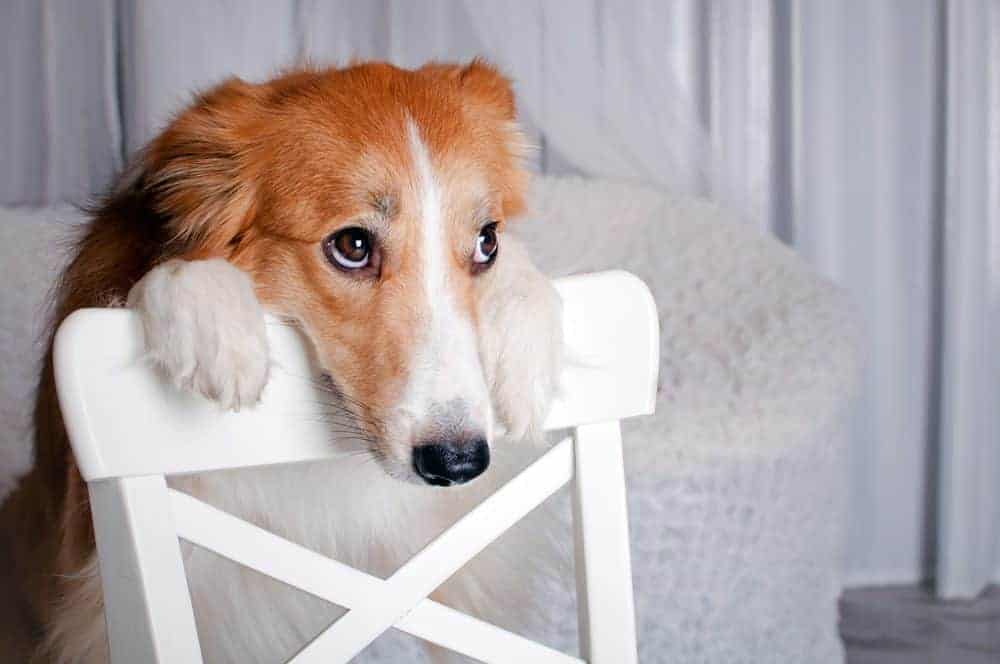
If you get home to find your dog has chewed up your slippers, and you react with a rather cross ‘what have you done?’ accusation, you may recognise the ‘guilty dog’ expression. The sad eyes, the hunched over body with tucked-in tail and head hung low, avoiding eye contact. Your dog knows they’ve done something wrong, right? In fact, your pet is simply reacting to your tone of voice and body language.
It’s Me or the Dog’s Victoria Stilwell explains it like this: “Behaviourists have long questioned the belief that dogs feel guilt or shame for their actions. In order for a dog to experience guilt he has to have what is known as theory of mind, in other words he has to be aware of how his behaviour impacts others. This is a complex level of thinking that has only been attributed to a select few species. So why does your dog look so guilty when you catch him chewing on something inappropriate or when you find an accident in the house? Most likely, your dog is responding solely to your body language, rather than as a result of feeling guilty for making a mistake.”
“Dogs that look guilty are doing nothing more than responding to an owner’s disappointment, upset or anger and it is their way of diffusing tension in response to feeling threatened”
Diffusing tension
While owners often think their dog knows they’ve done wrong, what they’re actually seeing is ‘appeasement behaviour’. Animal charity Blue Cross states: “Dogs that look guilty are doing nothing more than responding to an owner’s disappointment, upset or anger and it is their way of diffusing tension in response to feeling threatened. They’re more likely to do this is they’ve been told off in the past.”
In fact, dogs do this because they’re so good at reading humans – what we need to do is become better at reading them. Victoria Stilwell comments: “In order to survive and thrive as our domestic companions, dogs have evolved over time to deeply understand human body language. They watch our faces closely and take cues from the signals we give off, either intentionally or unintentionally. As a result, it's likely that dogs have learned that when their owner appears angry and upset, what we see as the ‘guilty’ look is actually their effort to appease us and has nothing to do with the dog knowing what he did wrong.”
A telling off is the worst thing to do
The worst thing you can do is punish your dog. It’s likely that they have chewed up something out of boredom or anxiety and telling them off won’t stop the behaviour – it will just increase their anxiety and make the problem worse.
Blue Cross advises: “Any punishment given on returning home won’t help stop the problem. Dogs associate punishment with what they are doing at that moment in time and so a dog will not link the telling off with their actions before their owner came home, even if they are taken over to ‘the scene of the crime’. It is not that they cannot remember what happened; they just won’t be able to make a connection between the punishment and something they did hours ago. Now, as well as being anxious about being left, a dog will also be worried about the owner returning, which can make any symptoms much, much worse.”
How to help your dog
- Make sure they have all the exercise they need – most dogs need at least an hour a day, active breeds require more
- Provide plenty of games – from tuggy time, fetch, to hide and seek and puzzle toys, to keep them mentally stimulated. Here are some ideas to get you started >>
- Provide a range of safe toys that they are allowed to chew – most dogs find chewing very soothing
- Take the time to train your dog to manage time on their own so they feel calm and safe – we’ve lots of tips here >>
- The RSPCA advises that dogs should not be left alone for more than four hours
If you found this interesting, you may also like:
The value of reward-based training with your dog Focusing on and rewarding what your dog can do, rather than what they can’t, makes training a much more positive experience for canines and humans alike
Tailor your training to your dog's personality When it comes to teaching your dog new stuff, it’s never a case of one size fits all. Canine behaviour experts agree that tailoring your approach by understanding the way your dog learns is key to success
Scratch and sniff? When you take your dog out for a walk, do you allow them time to follow their nose and enjoy lots of sniffing activity? Find out why having a good sniff is super important to your canine pal – and how it can even help address behaviour issues
Do you talk to your dog? Research reveals that dogs can understand human communication in ways no other species can. Yet, according to a survey by Dogs Trust, only 1 in 5 dog owners think that bonding with their dog includes actually chatting with them. Are humans missing a trick?
Sources: bluecross.org.uk, positively.com, rspca.org.uk














